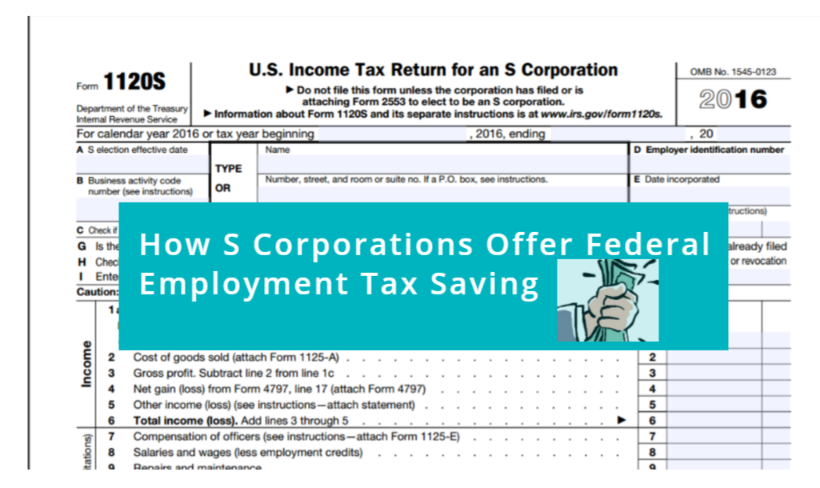How S Corporations Offer Federal Employment Tax Savings

 Does the headache of owning a small unincorporated business frustrate you because of exorbitant self-employment (SE) taxes? There is a way to eliminate this aggravation: convert your unincorporated business into an S corporation! Let’s take a look at the dynamics behind doing so.
Does the headache of owning a small unincorporated business frustrate you because of exorbitant self-employment (SE) taxes? There is a way to eliminate this aggravation: convert your unincorporated business into an S corporation! Let’s take a look at the dynamics behind doing so.
SE Taxes – Definition and Calculation Methodology
The SE tax applies to your sole proprietorship income in addition to that income which, with the exception of a minute number of limited partners, flows through to partners. For federal tax purposes, the same SE tax regulations also apply to single and multi-member limited liability companies (LLCs)- when treated as sole proprietorships and partnerships, respectively. For the purpose of this post, Medicare and Social Security taxes are grouped together and collectively referred to as federal employment taxes.
The calculation of your federal SE taxes is not the simplest of equations. For example, in 2017, the federal SE tax rate of 15.3% is only based on your first $127,200 of SE net income. After that dollar threshold is reached, any net income over $127,200 is taxed at a much lower rate of 2.9%. Why? As mentioned, the SE federal tax rate has two components: Social Security taxes and Medicare taxes. In 2017, Social Security taxes comprise 12.4% of the aforementioned 15.3%; your Medicare taxes make up the remaining 2.9% (12.4% + 2.9% = 15.3%.) Earnings over $127,200 are not subject to Social Security taxes but they are subject to Medicare taxes of 2.9%. High earners are subject to an additional 0.9% Medicare tax on top of this 2.9% for a total percentage of 3.8% (2.9% + 0.9% = 3.8%.) You are subject to the 3.8% if you meet any of the following income criteria:
- $200,000 for heads of households and single filers
- $250,000 for married couples filing jointly
- $125,000 per spouse for married couples filing separately
Please note that this additional 0.9% Medicare surtax is expected to be phased out as it was introduced with the Affordable Care Act (ACA). Please also note that dollar thresholds for SE Federal taxing also it increases every year due to inflation and business growth; in 2016, the dollar threshold was $118,500- close to $10,000 less than the going rate in 2017.
To make this calculation easier to understand, let’s walk through an example using a hypothetical sole proprietorship which generates a net SE income of $150,000. The following calculation would be used to determine the federal SE taxes owed:
[($127,500 x 15.3%) + ($22,500 x 2.9%)] = $19,461.60 + $652.50 = $20,114.10
SE Tax Reduction via Conversion to an S Corporation
There are many legal ways that you can lower your current and future federal SE taxes. One of the most effective ways is to restructure the framework of your unincorporated small business into an S corporation. Where the United States federal government is concerned, an S corporation is an intimately held corporation, and sometimes an LLC or partnership, which elects to be taxed under Subchapter S of Chapter 1 of the Internal Revenue Code. As a rule of this election, S corporations do not pay federal taxes. Rather, income, or lack thereof, is passed through to the corporation’s shareholders. The key here is that these shareholders must report income, losses, deductions and credits on their personal tax returns.
In order for this strategy to actually work, and for you to realize any benefits on the SE tax side, you will usually have to pay yourself and any shareholders/employees quite modest salaries because of the pass through income those individuals will receive. You can then make federal-employment-tax-free distributions by dispersing basically all post-salary cash flow to your shareholders/employees. These distributions are not taxed because they have already been taxed as entity earnings.
Let’s take a look at some basic but very important qualifications that an entity must meet in order to qualify for S corporation status:
- You offer only one class of stock
- You shareholders are limited to individuals (with certain rare exceptions for trusts, estates and tax-exempt organizations)
-
- A single shareholder does not necessarily mean one single person. Generally, anyone lineally descended from a common ancestor (family) will be grouped with other family members (as designated or elected) to form one shareholder or “individual”.
-
- You cannot exceed 100 shareholders
- You have no nonresident aliens as shareholders; all shareholders must be natural people
-
- This is why corporations and partnerships are not eligible to be shareholders.
- Rare exceptions can be made for trusts, estates and tax-exempt organizations
- An S-corporation can be considered a shareholder, but the laws governing this exception can get very complicated
-
Why this Federal SE Tax Strategy Works
For 2017, S corporation employee compensation is taxed at 7.65% on the first $127,200 of earnings. 7.65% represents the federal FICA tax rate, which is composed of your Medicare tax rate of 1.45% and your Social Security tax rate of 6.2% (1.45% + 6.2% = 7.65%). As is the case with federal SE taxes, earnings above $127,200 are not subject to the Social Security tax. Earners with over $127,200 remain subject to the Medicare tax of 1.45% and, after certain wage thresholds are reached, 0.9% is tacked on to this 1.45%.
Important to note here is that FICA taxes are automatically taken out of employee paychecks so the employer headache of determining federal SE taxes is avoided. Employers are required, however, to pay in matching amounts for the Medicare tax (not including the 0.9%) and Social security tax. Some employers view this as a downside since the matching percentage rates are identical to federal SE tax rates. However, the attractive component of S corporation taxing options is that only wages of employees/shareholders are taxed. Because S corporation tax guidelines only require a wage tax, all of the aforementioned taxable income that is passed through to employees/shareholders in the form of various cash distributions is not taxed. If arranged properly, this caveat benefits all sides.
($40,000 x 15.3%) = $6,120
Only $40,000 is subject to federal employment taxes! Under an S-corporation, only $6,120 is owed in taxes. Our first example demonstrating federal SE taxes requires a tax payment of $20,114.10 which is markedly higher.
Conclusion
Business conversion to an S corporation is a process that requires the utmost scrutiny and accuracy. Even if you have been successful at maintaining meticulous accounting records, consulting a professional CPA is the safest way to avoid any negative tax or legal implications, and virtually guarantee a seamless reorganization.



